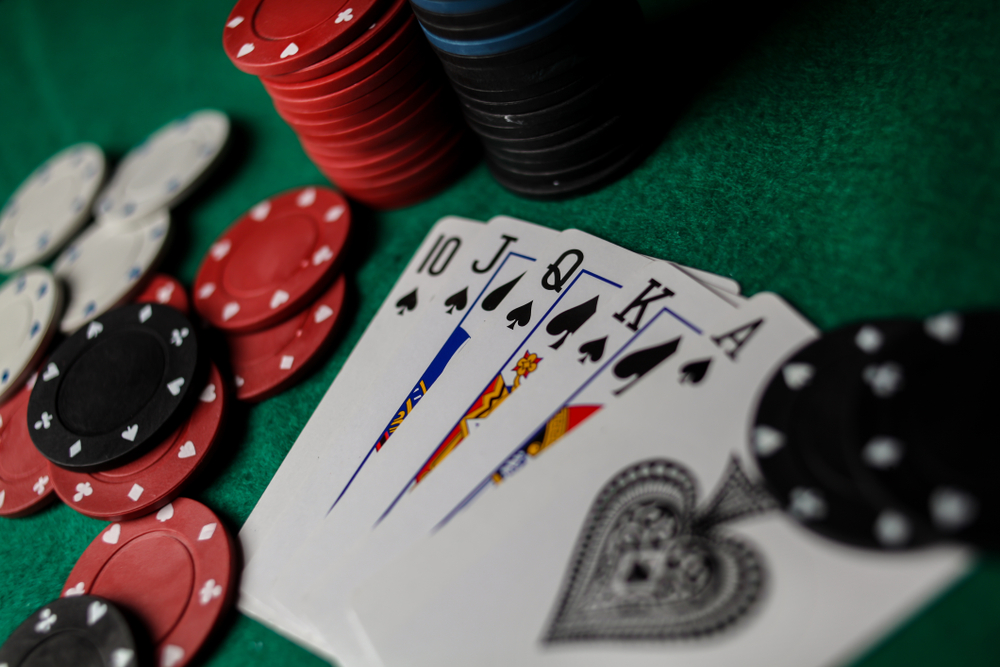Blackjack is a popular card game that is played in casinos all over the world. It is a game of skill and strategy, where players try to beat the dealer by getting as close to 21 points as possible without going over. The game is played with one or more decks of cards, and the objective is to have a higher hand than the dealer.
To start playing blackjack, a player must first place a bet. The dealer then deals two cards to each player, as well as two cards to themselves, with one card face up and one card face down. The player must then decide whether to hit (take another card), stand (keep their current hand), double down (double their bet and take one more card), or split (if they have two of the same card, they can split them into two separate hands). The dealer must follow a set of rules for hitting or standing, based on the value of their hand.
Learning how to play blackjack can be a fun and rewarding experience for players of all skill levels. With a basic understanding of the rules and strategies involved, players can increase their chances of winning and have a great time at the casino.
Understanding the Basics
The Objective
The objective of blackjack is to beat the dealer’s hand without going over 21. If a player’s hand exceeds 21, they lose the game. If the dealer’s hand exceeds 21, the player wins. If the player’s hand is closer to 21 than the dealer’s hand, the player wins.
Card Values
In blackjack, cards 2 through 10 are worth their face value. Kings, queens, and jacks are worth 10 points each. Aces can be worth either 1 or 11 points, depending on which value would be more beneficial to the player’s hand.
The Blackjack Table
A blackjack table typically seats up to 7 players. The dealer stands at the center of the table and deals the cards. Each player is dealt two cards, and the dealer is dealt one card face up and one card face down.
Players can then choose to “hit” and receive another card, or “stand” and keep their current hand. Players can also choose to “double down,” which means they double their initial bet in exchange for receiving one more card. If a player’s first two cards are of the same value, they can “split” the cards into two separate hands and play each hand individually.
It is important to note that the dealer must follow specific rules when playing their hand. The dealer must hit if their hand is worth less than 17 points and must stand if their hand is worth 17 or more points.
Understanding these basic rules and strategies is essential for any beginner blackjack player.
Gameplay
Placing Bets
Before the cards are dealt, players must place their bets. The minimum and maximum bets allowed are usually displayed on the table. Players place their chips in the designated area in front of them. It is important to note that players are not allowed to touch their bets once the cards have been dealt.
Dealing the Cards
Once all bets have been placed, the dealer deals two cards to each player, including themselves. One of the dealer’s cards is dealt face up, and the other is dealt face down. In some variations of blackjack, the dealer may deal themselves only one card face up.
Player’s Turn
After the cards are dealt, each player takes their turn to decide whether they want to “hit” (ask for another card) or “stand” (keep their current hand). Players can continue to hit until they reach a total of 21 or go over. If a player’s hand exceeds 21, they lose automatically.
In addition to hitting and standing, players may also have the option to “double down” (double their bet and receive one additional card) or “split” (if the player’s first two cards are of the same value, they can split them into two separate hands).
Dealer’s Turn
Once all players have completed their turns, the dealer reveals their face-down card. If the dealer’s hand is less than 17, they must hit until they reach a total of 17 or higher. If the dealer’s hand exceeds 21, all remaining players win. If the dealer’s hand is higher than the player’s hand without exceeding 21, the player loses their bet. If the player’s hand is higher than the dealer’s hand without exceeding 21, the player wins. If the player’s hand and the dealer’s hand are the same, it is a “push” and the player gets their bet back.
Special Scenarios
When playing blackjack, there are certain special scenarios that players may encounter which require specific actions. Here are some of the most common ones:
Splitting
If a player is dealt two cards of the same rank, they have the option to split them into two separate hands. This is done by placing an additional bet equal to the original bet. The player then plays each hand separately, with the option to hit, stand, or double down on each hand.
Splitting can be a powerful strategy, but it should be used judiciously. In general, it is recommended to split aces and eights, but not to split tens or fives.
Doubling Down
Doubling down is another option available to players. After receiving their initial two cards, a player can choose to double their bet and receive one additional card. This is often done when the player has a strong hand and believes that the next card will be to their advantage.
Players should be careful when doubling down, however, as it can also lead to a greater loss if the next card is not favorable.
Insurance
If the dealer’s up card is an ace, players have the option to take insurance. This is a side bet that the dealer has blackjack, and it pays out at 2:1 if the dealer does indeed have blackjack.
While insurance can seem like a tempting option, it is generally not recommended. The odds of the dealer having blackjack are relatively low, and taking insurance can lead to greater losses over time.
Surrender
Finally, players may have the option to surrender their hand if they believe it is unlikely to win. Surrendering allows the player to forfeit half of their bet and end the hand immediately.
Surrendering can be a useful option in certain situations, but it should be used with caution. In general, it is only recommended to surrender when the player has a very weak hand and the dealer has a strong up card.
Strategies
When it comes to playing blackjack, there are a few strategies that can help increase your chances of winning. In this section, we will discuss two popular strategies: Basic Strategy and Card Counting.
Basic Strategy
Basic Strategy is a set of rules that players follow to make the best possible decisions based on their hand and the dealer’s upcard. The strategy is based on mathematical calculations and has been proven to be effective in reducing the house edge.
To use Basic Strategy, players need to memorize a chart that tells them what action to take based on their hand and the dealer’s upcard. The chart takes into account the number of decks in play and whether the dealer hits or stands on a soft 17.
Some key points to keep in mind when using Basic Strategy include:
- Always hit a hard total of 8 or less.
- Always stand on a hard total of 17 or more.
- Double down on a total of 10 or 11 if the dealer’s upcard is 9 or lower.
- Never take insurance.
By following Basic Strategy, players can reduce the house edge to as low as 0.5%.
Card Counting
Card Counting is a strategy that involves keeping track of the cards that have been played to determine the ratio of high cards to low cards remaining in the deck. By doing this, players can make more informed decisions about when to bet and how much to bet.
There are several different card counting systems, but the most popular is the Hi-Lo system. In this system, cards 2-6 are assigned a value of +1, cards 7-9 are assigned a value of 0, and cards 10-Ace are assigned a value of -1.
The player keeps a running count of the cards as they are played, and then divides the running count by the number of decks remaining to get the true count. The higher the true count, the more the player should bet.
It’s important to note that card counting is not illegal, but it is frowned upon by casinos. Players who are caught counting cards may be asked to leave the casino or even banned from playing blackjack altogether.
Overall, both Basic Strategy and Card Counting can be effective strategies for playing blackjack. However, it’s important to remember that no strategy can guarantee a win, and players should always gamble responsibly.
Etiquette and Rules
When playing Blackjack, it is important to understand the basic rules and etiquette. The objective of the game is to beat the dealer’s hand without going over 21. If a player’s hand goes over 21, it is called a “bust” and they lose the round.
Basic Rules
Players are dealt two cards face up, while the dealer receives one card face up and one card face down. The player can choose to “hit” and receive another card, or “stand” and keep their current hand. They can also choose to “split” their hand if they have two identical cards, or “double down” and double their bet in exchange for one more card.
The value of the cards in Blackjack is straightforward. Numbered cards are worth their face value, while face cards (king, queen, jack) are worth 10. Aces can be worth either 1 or 11, depending on which value benefits the player more.
Etiquette
While playing Blackjack, it is important to follow certain etiquette rules to ensure a smooth game for all players. Here are some basic etiquette rules to follow:
- Do not touch your cards once they have been dealt face-up.
- Do not touch your chips once you have placed your bet.
- Do not touch the dealer’s cards or chips.
- Do not talk about your hand or give advice to other players.
- Do not take too long to make your decision.
- Do not be rude or disrespectful to the dealer or other players.
By following these basic rules and etiquette, players can enjoy a fun and fair game of Blackjack.
Glossary of Terms
Before diving into the game of blackjack, it’s important to understand the terminology used. Here are some of the most common terms you’ll come across:
- Blackjack: A hand consisting of an Ace and a 10-value card, totaling 21.
- Bust: When a player’s hand exceeds 21, resulting in an automatic loss.
- Double Down: A player’s option to double their original bet after receiving their first two cards. The player then receives one additional card.
- Hit: When a player requests an additional card to improve their hand.
- Insurance: A side bet that can be made when the dealer’s up card is an Ace. The bet pays 2:1 if the dealer has a blackjack.
- Push: A tie between the player and the dealer, resulting in the player’s bet being returned.
- Split: When a player’s first two cards are of the same rank, they have the option to split them into two separate hands.
- Stand: When a player decides to keep their current hand and not request any additional cards.
- Surrender: A player’s option to forfeit half of their bet and end the hand.
Understanding these terms is crucial to playing blackjack effectively. It’s recommended that players become familiar with these terms before sitting down at the table.
Frequently Asked Questions
What are the basic rules of blackjack?
The basic rules of blackjack are simple. The goal of the game is to beat the dealer’s hand without going over 21. Each player is dealt two cards face up, while the dealer receives one card face up and one card face down. Players can choose to “hit” and receive another card or “stand” with their current hand. Players can continue to hit until they choose to stand or go over 21, at which point they lose the hand. The dealer must hit until they reach a total of 17 or higher.
How do you play blackjack with friends?
To play blackjack with friends, you can follow the same basic rules as in a casino. Each player is dealt two cards, and the dealer receives one card face up and one card face down. Players can take turns being the dealer or designate one person to be the dealer for the entire game. It’s important to establish the rules and betting structure before starting the game to avoid any confusion or disagreements.
What are the rules to 21 blackjack?
The rules of 21 blackjack are the same as regular blackjack. The goal is to beat the dealer’s hand without going over 21. Each player is dealt two cards face up, while the dealer receives one card face up and one card face down. Players can choose to “hit” and receive another card or “stand” with their current hand. Players can continue to hit until they choose to stand or go over 21, at which point they lose the hand. The dealer must hit until they reach a total of 17 or higher.
How do you play blackjack at home without a dealer?
To play blackjack at home without a dealer, players can take turns being the dealer or use a designated dealer button. Each player is dealt two cards face up, and the dealer receives one card face up and one card face down. Players can follow the same basic rules as in a casino, choosing to hit or stand with their hand. It’s important to establish the rules and betting structure before starting the game to avoid any confusion or disagreements.
How do you play blackjack not in a casino?
To play blackjack outside of a casino, players can organize their own game with friends or participate in a blackjack tournament. The rules and betting structure may vary depending on the setting, so it’s important to clarify the rules before starting the game. Online blackjack is also an option, with many websites offering virtual blackjack games.
When do you bet in blackjack?
In blackjack, players place their bets before the cards are dealt. The minimum and maximum bets may vary depending on the table and casino. After the bets are placed, each player is dealt two cards, and the dealer receives one card face up and one card face down. Players can then choose to hit or stand with their hand, and the dealer must follow specific rules for hitting or standing.



